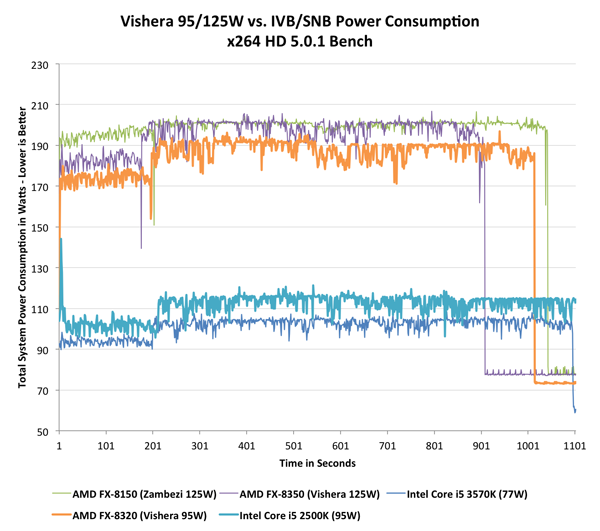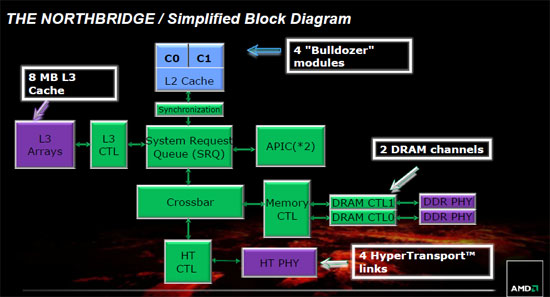IDC, you take the TDP as POWER USAGE.
125W TDP means that you need a Heat-Sink Fan able to dissipate 125W of heat from the processor
in order to keep the operating temperature of the chip within the limits set by the manufacturer(TJmax).
Since the two CPU dies of the 2500K and FX8320 (different die sizes, different power maps etc) and TJmax are different, 95W TDP will not make both CPUs use the same power.
Also once again, you forgetting that the FX8320 (and all AM3+ systems) has an extra North Bridge(
990FX) in the motherboard that adds up to 20W more power usage to the entire AM3+ system. Intel Core i5 2500K has the northbridge integrated in to the CPU die.
Once again, the TDP is not the power usage and two different chips can have the same TDP but different power usage.
I have to LOL a bit there (not at you, at the situation overall) because AMD got us good there. They won't even spec the max temperature for Piledriver, no TJmax period. So they may as well set TDP to 200W for all that it matters in that regard.
My point regarding TDP of the FX-8350 is that it is clearly a number that has no meaning, period. It lacks any specificity whatsoever.
It is true there is no max-power spec for the FX8350. It is also true there is no max temperature spec, and no max voltage spec.
In fact good luck (as you know, and as you know that I know) finding specs on the 8350 for practically any electrical parameter

But MSI's engineers would know, as would AMD's engineers. And I doubt very much that MSI's engineers would go off on their own, without any good reason or out of ignorance to their job and profession, and craft the power-consumption limiter as they did combined with guiding their technical support team to the specifics of the issue. (complete with linking to my very thread in these forums on the topic of FX-8350's power consumption)
Those facts are very telling. And the lack facts (from AMD) are very telling.
IDC , no one dispute the fact that the FX consume notably more
than the i7 but anyway i find odd that TR get 20W less than you
at iddle while using the same MB and a HD7950 and another site
did get even lower figures.
For loaded power they got 140-150W more , wich correlate
with the VRMs efficencies as well as with increased compsumption
of the MB itself.
The randomicity of silicon processes is countered simply by binning
the chips , that is , if it consume more than average it is relegated
as a lower frequency part , eventualy even a lower core count part.
I'm not surprised my idle power is 20W higher than theirs, they are using an HD7950 which has AMD's very nice "deep idle" power consumption whereas I am using an MSI GTX460 Cyclone edition (factory OC model) that sucks power even when idle.
However, regardless how much power the GTX460 is sucking down when in 2D idle mode that is the same amount it is sucking down when running LinX or Prime95. The baseline power usage is present in the loaded power usage.
It is the delta between loaded and idle that is troublesome because the only thing that changes is the CPU loaded rate.
But maybe I got a questionably binned 8350. That can't be ruled out. In fact I'd put my money on that being the answer. AMD knows what samples it is sending to reviewers, not that they cherry pick the golden samples but they surely are savvy enough to avoid sending review samples from the right-hand side of the distribution for power vs clockspeed.
But retail gets shipped samples from all parts of the distribution, and it is that high-power end of the distribution that MSI is intending to protect itself from. For example, say hypothetically only 10% of the 8350 CPU's AMD use >125W when fully loaded with prime95. That means 9 out 10 8350 aren't going to notice or have an issue with it, and it also means that 9 out of 10 MSI mobos aren't going to be challenged by a high-power usage CPU.
But it also means 1 out 10 are. Now what happens when that one guy out of ten happens to post his results in a forum? People post up review results and tell him he's crazy or has a bad setup. And what happens if he happens to have an MSI board and he emails MSI asking about the weird temperature issue? They tell him the truth, that AMD ships processors that exceed the power spec and so MSI intentionally throttles those processors when they happen to make it onto an MSI mobo.
People can discount my data, they can discount my setup or my thinking. I'm used to it, it doesn't insult me or offend me. But people should take notice when a tier-1 board supplier like MSI is willing to go on record stating what they have stated. They know the statistics, they have the samples. LC and I do not have samples to speak to distributions and probabilities, but MSI will and did...and their conclusion is there to read in black and white.
To discount their statements, in light of the anecdotal evidence peppered in forums with threads like mine and other members, it is definitely a "missing the forest for the trees" situation IMO at that point. There is too much smoke, and MSI is on record saying they have seen the fire.
My FX8350 may be an outlier, but MSI didn't implement throttling for no good reason.








